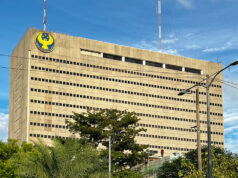By Lourdes O. Pilar, Researcher
YIELDS ON government securities (GS) traded in the secondary market ended flat last week as investors await new market cues amid the holiday season.
On average, GS yields — which move opposite to prices — went down on average by 0.7 basis point (bp) week on week, based on the PHP Bloomberg Valuation Service Reference Rates as of Dec. 27 published on the Philippine Dealing System’s website.
Financial markets were closed for the holidays on Dec. 30 to Jan. 1.
“Yields moved sideways to slightly down this short work week as market players stayed mostly in the sidelines ahead of the Christmas holidays, with most only servicing end client requirements or positioning lightly for next year,” Carlyn Therese X. Dulay, first vice-president and head of Wholesale Treasury Sales at Security Bank Corp., said in an e-mail interview.
For Rizal Commercial Banking Corp. (RCBC) Chief Economist Michael L. Ricafort, local benchmark tenors edged lower week on week after tracking the easing of benchmark yields in the US and other developed countries.
“Lower yields also partly brought about by recent gains in emerging markets amid improved global market risk appetite in optimism that the phase one US-China trade deal could be signed as early as January 2020…,” Mr. Ricafort said in an e-mail.
“On local factors, BSP (Bangko Sentral ng Pilipinas) Governor Benjamin E. Diokno reiterated possible 0.50-bp cut in local policy rates in 2020 and also signaled that the BSP is not in a hurry to cut RRR (reserve requirement ratio),” he said.
“Market sentiment also improved after President Rodrigo R. Duterte’s approval to extend the 2019 government budget until 2020 to make up for the delay in the approval of the 2019 national budget earlier this year,” added Mr. Ricafort.
Reuters reported late last month that US President Donald J. Trump said he and Chinese President Xi Jinping will hold a signing ceremony to sign the Phase 1 deal that was finalized before yearend.
Meanwhile, China has yet to confirm the details of the trade agreement released by US officials with the former’s Commerce Ministry saying the specific components of the deal will be made public after the official signing.
At home, Mr. Duterte signed the Republic Act No. 11464 on Dec. 20, but was only announced last Thursday. The act will extend the availability of the 2019 budget until Dec. 31 this year to make up for the four-month delay in passing the 2019 fiscal program which slowed economic expansion in the first semester of last year.
Also, the central bank cut benchmark interest rates by a total of 75 bps last year, dialing back a 175 bps worth of hike in 2018 to tame a high inflation environment that averaged 5.2%.
The BSP chief signaled that he sees at least 50-bp cut in benchmark interest rates in 2020, but added that the central bank is not in a hurry to cut banks’ RRR.
At the secondary market on last Dec. 27, yields on Treasury bills (T-bills) fell compared to their week-ago levels. The 91-, 182-, and 364-day T-bills dropped 0.5 bp, 0.1 bp, and 4.8 bps to yield 3.204%, 3.373%, and 3.415%, respectively.
At the belly, the two-, three-, four-, five-, and seven-year Treasury bonds (T-bonds) saw their yields rise by 2 bps (3.738%), 2.1 bps (3.830%), 2.2 bps (3.940%), 2.1 bps (4.061%) and 0.1 bp (4.729%), respectively.
On the other hand, rates of the 10-, 20-, and 25-year T-bonds declined by 4.3 bps, 4.9 bps, and 1.2 bps, respectively, to fetch 4.461%, 5.159%, and 5.218%.
For this week, Security Bank’s Ms. Dulay expects yields to stay within range.
“Expect next week to stay quiet as well, with the New Year’s holidays and another short work week,” said Ms. Dulay.
Meanwhile, RCBC’s Mr. Ricafort said yields could still continue to ease depending on December’s inflation data.
“Local interest rate benchmarks could still continue to ease [this] week amid relatively low/benign inflation… as the market remains relatively liquid after the total RRR cuts have so far in 2019 infused more than P450 billion in additional peso funds into the local banking system,” said Mr. Ricafort.
Mr. Ricafort added: “The financial markets would be anticipating for the latest inflation data as a major source of leads/cues for direction in the local financial markets, including local interest rate benchmarks.”



